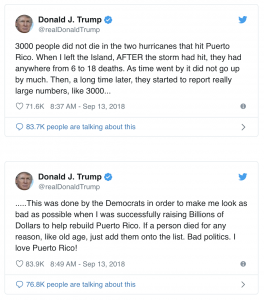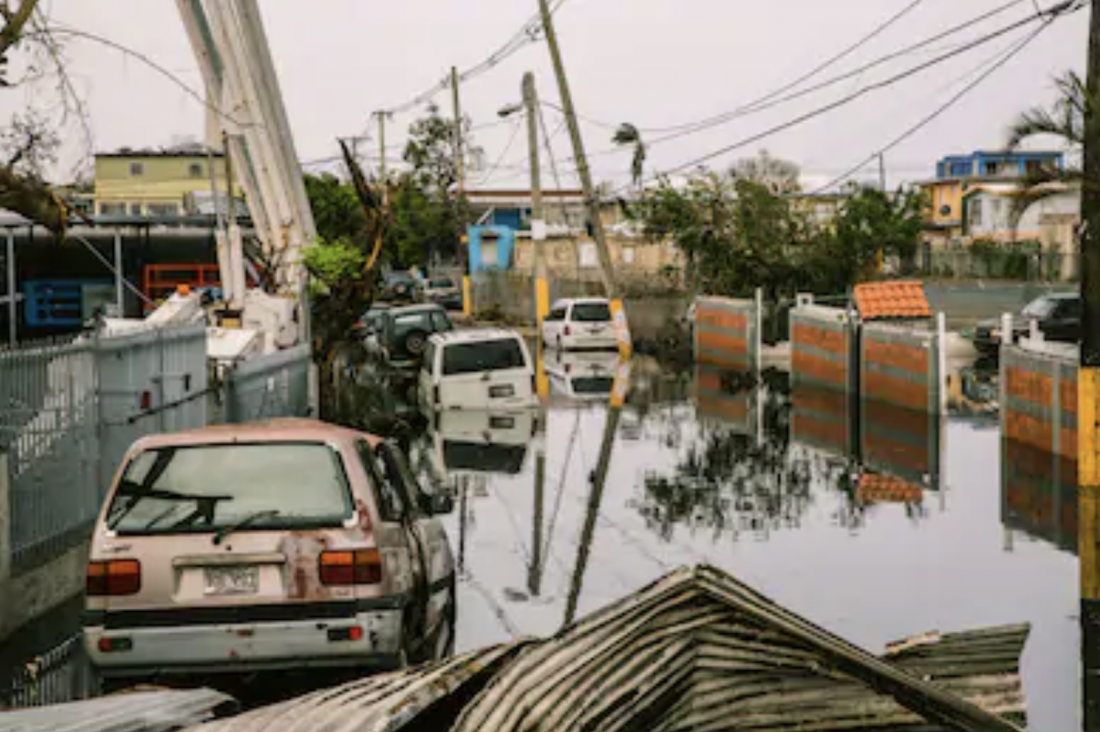By A. E. King
In September 2017, a massive hurricane formed and attacked Puerto Rico. Only the second category five storm ever recorded, it caused communication blackouts, intense flooding, and lengthy power outages. Information following the aftermath of the storm was convoluted. In the end, it was determined that the storm caused roughly 3,000 casualties.
Unfortunately, rather than lay this catastrophe to bed and help the nation rebuild, President Donald Trump pushed the tragedy to infamy with his tweeting.
President Donald Trump tweeted on September 2018, “AFTER the storm had hit, they had anywhere from six to eighteen deaths. As time went by it did not go up by much.” He continued, “This was done by the Democrats in order to make me look as bad as possible when I was successfully raising Billions of Dollars to help rebuild Puerto Rico.” Trump further blamed the inflation of deaths to convenience and minimal correlation (such as casualties of old age), and thoroughly denied the official consensus.

In reality, conspiracies or political sabotage do not explain the changing death count. The New York Times focused a “fact check of the day” article on casualty figures as well as the President’s claims. Soon after the storm hit, Puerto Rico’s government released a statement reporting 64 official fatalities in the hurricane. Immediately there was an international backlash. Devastation was still visibly affecting the economy, geography, and society on the island, and In response to claims of indifference, the Puerto Rican government took matters into their own hands and commissioned a study. Once released, the findings by students at George Washington University (GWU) estimated 2,975 deaths in the wake of the storm, an almost 4,500% increase in estimated deaths.
Despite this new information, however, the important thing to note is that neither tally, original or revised, was as low as six to eighteen.
What Trump’s tweet shows is a disturbing trend away from expertise and evidence, and towards political and personal experience. Trump is putting stock in both his own observations and in his personal political agenda, defending a turn for the self-relying wisdom of common sense over the data of experts. This trend has been remarked on before in Trump’s career, by historian Sophia Rosenfeld as she critiques Trump’s authoritarian approach to “fact-free fantasy” information. In her article, Rosenfeld discusses a trend in Trump’s Presidency to negate evidence, a moving current that has him neglecting evidence and endorsing the loyalty of “common-sense.” Rosenfeld further defines it as a set of “widely shared and seemingly self-evident conclusions.” This common-sense nurtures popular belief and trends. It rejects the ulterior motive of expertise, thriving instead on the cold hard facts of personal experience.
This is how Trump is able to claim such low numbers of the death toll. If he himself saw six to eight deaths, with no further physical proof of Maria’s effects, then he cannot accept anything beyond that. Trump is witty, fast, and unpretentious. This is the common-sense narrative, to speak only to what you have seen and experienced and justify it thusly. The goal eventually is to change the impressions of others around you by wielding the misguided weapon of perception.
Trump’s loyalists come in is how his tweets are formulated to be received by people of the same or agreeing mentalities. His followers are expected to think critically of the world around them in an experiential sense and use only first-hand perception of information to craft a personal narrative. Trump is both the journey and destination, therefore, as he utilizes the people’s common sense to incline them towards his opinions, then leaves it vague and personable enough to let them draw their own conclusions at his feet. This style of knowledge is effective in shutting intruding evidence down and out and maintaining pride in personal opinion instead. People can find comfort in their personal bias, deciding for themselves what is truth.
Common sense utilizes emotion, simplicity, and communication to relate to others. Trump’s aversion to academia such as the officially accepted study from GWU perfectly encapsulates the struggle between experts in researching and experts in tweeting.
This case perpetuates a cycle of suspicion in news. The tension between experts and people is heightened by each case of neglect and disrespect. Trump’s apathy towards Puerto Rico and disregard of an official peer-reviewed case study increases animosity and doubt within the American political environment, as well as sowing paranoia into the minds of his followers regarding expertise and authority figures. Fact is traded in for accusations and opinions, changing the landscape of politics to one of mistrust and doubt. Trump’s tweet may have been wrong in its evaluation, but how it will truly affect readers thereafter is very real indeed.
